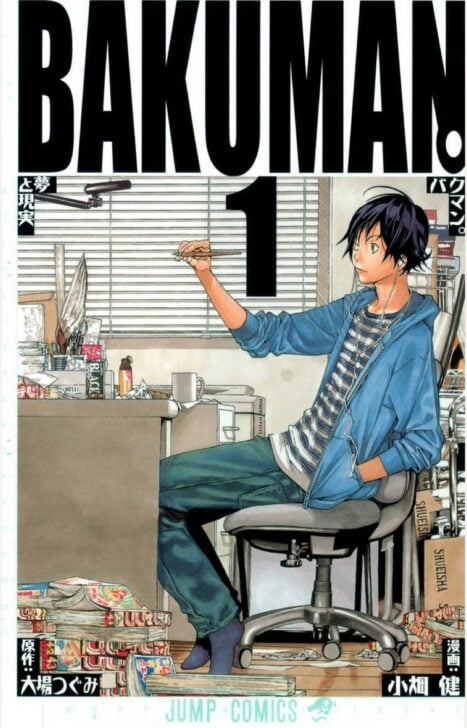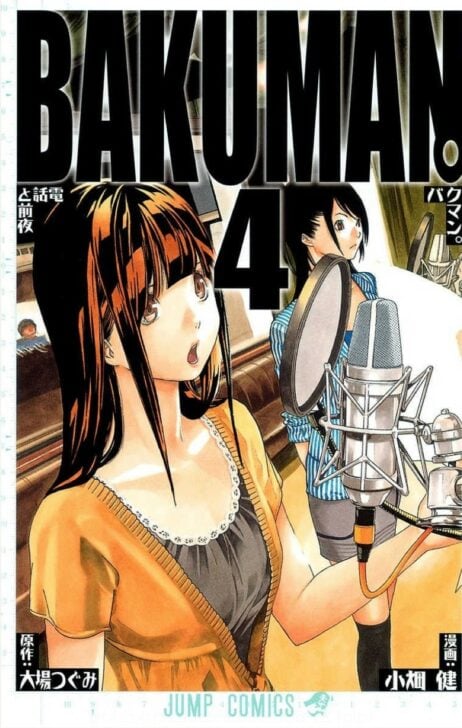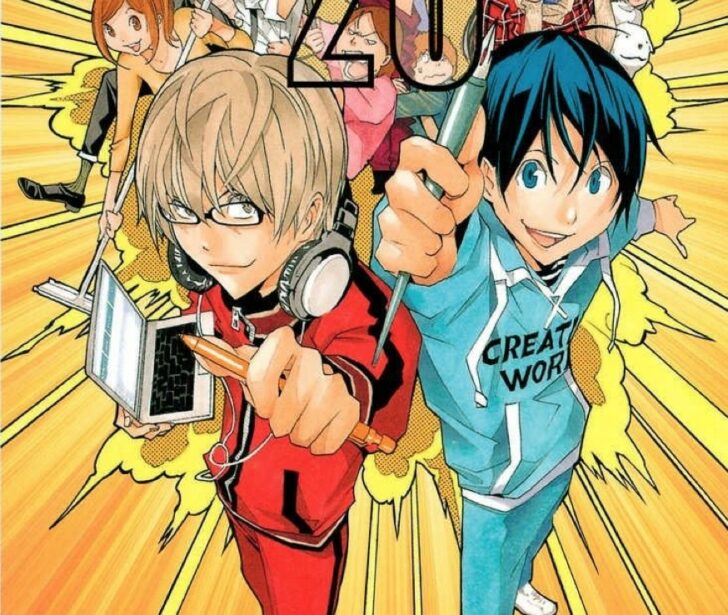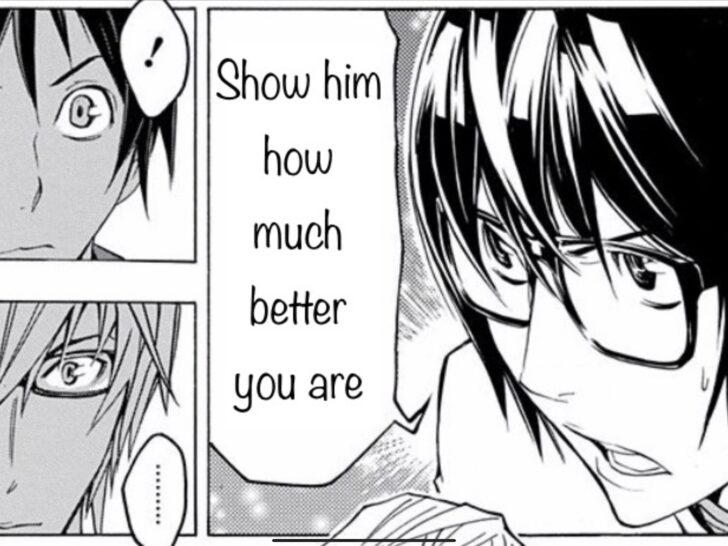Share this link via
Or copy link
Below are navigation links that will take you to the main text and navigation menus.
26,551 first names, 70,620 last names, 333,585 kanji variations.
one of the best Japanese name search tools for your baby!

Image by: Bakuman comic 2 ©Tsugumi Oba, Takeshi Obata/Shueisha Inc
Contents
This manga series is written by Tsugumi Oba and illustrated by Takeshi Obata. This is a story about two high school students Moritaka Mashiro and Akito Takagi aiming to be successful manga writers. Akito had a dream to be a story writer when one day he discovered his classmate Moritaka was so good at drawing pictures. Akito immediately askes Moritaka to be his partner and create manga together. It is a great story that gives you a positive feeling and a touch of the competitive world of manga creating.

Image by: Bakuman comic 1 ©Tsugumi Oba, Takeshi Obata/Shueisha Inc
The title ‘Bakuman’ is both used in the Japanese and English versions and is written in Katakana.

Image by: Bakuman comic 1 ©Tsugumi Oba, Takeshi Obata/Shueisha Inc
In Japanese culture, names have significant meanings that are supposed to represent you as a person. Names can be expressed in hiragana, katakana, and kanji. Let’s find out the meanings of some names of characters in Bakuman.

Image by: Bakuman comic 9 Ep 71 ©Tsugumi Oba, Takeshi Obata/Shueisha Inc
Moritaka, the main character of the series is a talented illustrator and has won several awards for drawing. ‘Ma’(真) means true, ‘Shiro’(城) is a castle, ‘Mori’(最) means the most and ‘Taka’(高) means high. Akito calls him ‘Saikō’(サイコー) because his name ‘Moritaka’(最高) can be read ‘Saikou’ too and it means the best!

Image by: Bakuman comic 2 ©Tsugumi Oba, Takeshi Obata/Shueisha Inc
Akito is a great story writer and also one of the smartest in class. ‘Taka’(高) means high, ‘Gi’(木) also read as ‘Ki’ is a tree, ‘Aki’(秋) means autumn and ‘To’(人) is a person. Moritaka calls him ‘Shūjin’ because of the other sound of the kanji ‘Shu’(秋) and ‘Jin’(人).

Image by: Bakuman comic 4 ©Tsugumi Oba, Takeshi Obata/Shueisha Inc
While Moritaka and Akito are working to become manga writers, Miho aims to be a voice actress. ‘A’(亜) means next, ‘Zuki’(豆) is a bean, ‘Mi’(美) means beauty and ‘Ho’(保) means to maintain.

Image by: Bakuman comic 20 ©Tsugumi Oba, Takeshi Obata/Shueisha Inc
This is Moritaka and Akito’s pen name as a manga creator. The two boys and Miho promised to work hard for their dreams, so combined their surname ‘Azuki’(亜豆), ‘Mashiro’(真城) and ‘Takagi’(高木) to become ‘Ashirogi’(亜城木). ‘Mu’(夢) means dream and ‘To’(叶) means come true.

Image by: Bakuman comic 11 ©Tsugumi Oba, Takeshi Obata/Shueisha Inc
Eiji is a famous manga creator and is called a genius because of his talents in drawing. ‘Nii’(新) means new, ‘Zuma’(妻) means wife. ‘Eiji’(エイジ) is written in Katakana but there are many ways to write this name in kanji. This is quite a common name, here are more ways to write Eiji.

Image by: Bakuman comic 9 ©Tsugumi Oba, Takeshi Obata/Shueisha Inc
Ko is one of the manga creators who works for the manga magazine ‘Weekly Jump’. Kind and gentle Ko is a good friend of Moritaka and Akito who encourage each other to grow as manga creators. ‘Ao’(蒼) means blue, ‘Ki’(樹) is a tree, and ‘Ko’(紅) means red. Her real name is ‘青木 優梨子’ (Aoki Yuriko). ‘Ao’(青) is blue, ‘Ki’(木) means tree, ‘Yu’(優) means kind, ‘Ri’(梨) is a pear and ‘Ko’(子) means child and is a common ending for girls names. As you can see, there are different kanji used for the same sound. They have basically the same meaning but with a slight difference. ‘青’(Ao) means the color blue but the kanji ‘蒼’(Ao) is mainly used to describe blue things such as sky, sea, or even pale. The kanji ‘Ki’ has an interesting difference too. Both 木 and 樹 means tree but ‘樹’ is only used for trees growing from the ground while ‘木’ is used for a tree growing or chopped off.
Here are some useful phrases from Bakuman which will help you along with your Japanese studies!

Image by: Bakuman comic 5 Ep 35 ©Tsugumi Oba, Takeshi Obata/Shueisha Inc
‘Omoshiroi’ means interesting. ‘Yomu’ is to read and ‘__sete Kure’ means let me. So when you combine it becomes ‘Let me read.’

Image by: Bakuman comic 15 Ep 125 ©Tsugumi Oba, Takeshi Obata/Shueisha Inc
The manga industry is competitive. If you are not popular you won’t get a chance to continue the series. ‘Sa’(差) is the difference and ‘Misetsukeru’ means to show off.
Sort by Most Kanji Variations
This is the order of names with many variations of kanji.
Basically, names with more variations are more common and familiar to the Japanese.
Sort by Most Viewed
The names are sorted by the number of times they have been viewed on this site. This ranking is based on the behavior of users around the world, including Japan, so it does not mean that the names are commonly viewed by Japanese people only.
Please note that just because a name has been viewed more times does not mean it is a famous name in Japan.
What is Hiragana?
Hiragana is a syllabary used in written Japanese, which originated from the cursive style of Kanji.
What is Katakana?
Katakana is also a Japanese syllabary. Basically, the characters don't have any meaning by themselves, they only represent the sounds.
Japanese try to express the words came from foreign languages with the most similar sounds in Japanese using Katakana.
What is English Transcription?
English Transcription is a term used when translating Japanese names into English. It represents a romanised version of the name with the aim of reproducing the pronunciation as accurately as possible. English Transcription can also be used for name searches.
Japanese Style Nickname
In Japan, nicknames are commonly used to express familiarity and affection. Here are key features and contexts:
Shortened Forms: Names are often shortened for ease and intimacy, such as 'Yuki' from 'Yukiko' or 'Taka' from 'Takashi'.
Suffixes: Terms like 'chan' for girls and 'kun' for boys are added to names among close friends and family. However, 'chan' can also be used for boys during childhood. Additionally, among adults who are very close, like best friends, 'chan' may still be used to convey affection and familiarity. More Details
Usage and Cultural Aspects: Nicknames are typically used in informal settings among friends, family, or close colleagues, and are not suitable for formal or professional environments. The use of a nickname suggests a degree of intimacy and should reflect the nature of the relationship. Young people often demonstrate creativity in their social interactions by crafting unique nicknames.
Note: In Japanese, the long vowel sound is indicated by a special character called a "chōonpu" (長音符), which looks like a horizontal dash (ー). This character serves to extend the duration of the vowel sound immediately preceding it. For instance, in the name "あーちゃん" (A-chan), the "あ" (A) is extended, producing a prolonged "ah" sound, similar to the "a" in "father."
Households?
The names are sorted by the number of Japanese households where the surname is used.
The more households there are, the more famous and common the surname is.
About this site's data of last names
